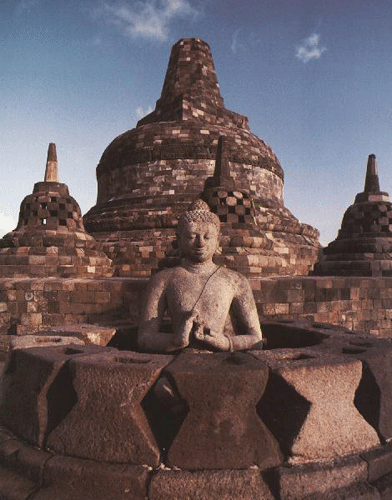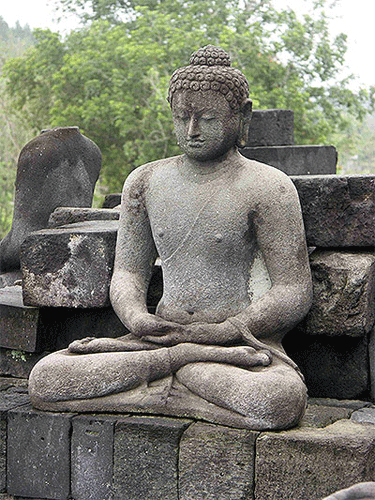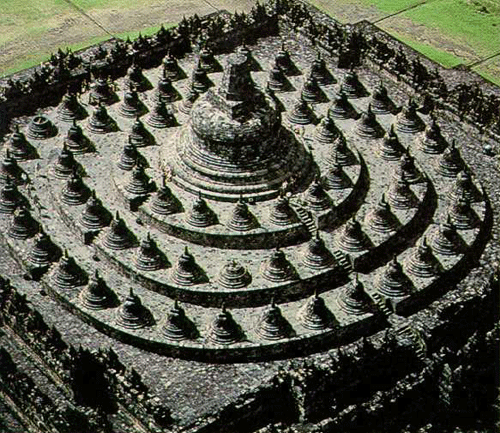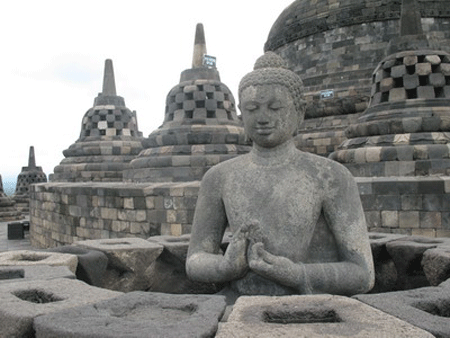Etymology
In Indonesian, ancient temples are known as candi; thus “Borobudur Temple” is locally known as Candi Borobudur. The term candi is also used more loosely to describe any ancient structure, for example gates and bathing structures. The origins of the name Borobudur however are unclear, although the original names of most ancient Indonesian temples are no longer known. The name Borobudur was first written in Sir Thomas Raffles’ book on Javan history. Raffles wrote about a monument called borobudur, but there are no older documents suggesting the same name. The only old Javanese manuscript that hints at the monument as a holy Buddhist sanctuary is Nagarakretagama, written by Mpu Prapanca in 1365.
The name ‘Bore-Budur’, and thus ‘BoroBudur’, is thought to have been written by Raffles in English grammar to mean the nearby village of Bore; most candi are named after a nearby village. If it followed Javanese language, the monument should have been named ‘BudurBoro’. Raffles also suggested that ‘Budur’ might correspond to the modern Javanese word Buda (‘ancient’) – i.e., ‘ancient Boro’. However, another archaeologist suggests the second component of the name (‘Budur’) comes from Javanese term bhudhara (mountain).
Karangtengah inscription dated 824 mentioned about the sima (tax free) lands awarded by Çrī Kahulunan (Pramodhawardhani) to ensure the funding and maintenance of a Kamūlān called Bhūmisambhāra. Kamūlān itself from the word mula which means ‘the place of origin’, a sacred building to honor the ancestors, probably the ancestors of the Sailendras. Casparis suggested that Bhūmi Sambhāra Bhudhāra which in Sanskrit means “The mountain of combined virtues of the ten stages of Boddhisattvahood”, was the original name of Borobudur.
Location
Approximately 40 kilometers (25 mi) northwest of Yogyakarta, Borobudur is located in an elevated area between two twin volcanoes, Sundoro-Sumbing and Merbabu-Merapi, and two rivers, the Progo and the Elo. According to local myth, the area known as Kedu Plain is a Javanese ‘sacred’ place and has been dubbed ‘the garden of Java’ due to its high agricultural fertility. Besides Borobudur, there are other Buddhist and Hindu temples in the area, including the Prambanan temples compound. During the restoration in the early 1900s, it was discovered that three Buddhist temples in the region, Borobudur, Pawon and Mendut, are lined in one straight line position. It might be accidental, but the temples’ alignment is in conjunction with a native folk tale that a long time ago, there was a brick-paved road from Borobudur to Mendut with walls on both sides. The three temples (Borobudur–Pawon–Mendut) have similar architecture and ornamentation derived from the same time period, which suggests that ritual relationship between the three temples, in order to have formed a sacred unity, must have existed, although exact ritual process is yet unknown.
Unlike other temples, which were built on a flat surface, Borobudur was built on a bedrock hill, 265 m (869 ft) above sea level and 15 m (49 ft) above the floor of the dried-out paleolake. The lake’s existence was the subject of intense discussion among archaeologists in the twentieth century; Borobudur was thought to have been built on a lake shore or even floated on a lake. In 1931, a Dutch artist and a scholar of Hindu and Buddhist architecture, W.O.J. Nieuwenkamp, developed a theory that Kedu Plain was once a lake and Borobudur initially represented a lotus flower floating on the lake. Lotus flowers are found in almost every Buddhist work of art, often serving as a throne for buddhas and base for stupas. The architecture of Borobudur itself suggests a lotus depiction, in which Buddha postures in Borobudur symbolize the Lotus Sutra, mostly found in many Mahayana Buddhism (a school of Buddhism widely spread in the east Asia region) texts. Three circular platforms on the top are also thought to represent a lotus leaf. Nieuwenkamp’s theory, however, was contested by many archaeologists because the natural environment surrounding the monument is a dry land.
Geologists, on the other hand, support Nieuwenkamp’s view, pointing out clay sediments found near the site. A study of stratigraphy, sediment and pollen samples conducted in 2000 supports the existence of a paleolake environment near Borobudur, which tends to confirm Nieuwenkamp’s theory. The lake area fluctuated with time and the study also proves that Borobudur was near the lake shore circa thirteenth and fourteenth century. River flows and volcanic activities shape the surrounding landscape, including the lake. One of the most active volcanoes in Indonesia, Mount Merapi, is in the direct vicinity of Borobudur and has been very active since the Pleistocene.
History
Construction
There is no written record of who built Borobudur or of its intended purpose. The construction time has been estimated by comparison between carved reliefs on the temple’s hidden foot and the inscriptions commonly used in royal charters during the eight and ninth centuries. Borobudur was likely founded around 800 AD. This corresponds to the period between 760–830 AD, the peak of the Sailendra dynasty in central Java, when it was under the influence of the Srivijayan Empire. The construction has been estimated to have taken 75 years and been completed during the reign of Samaratungga in 825.
There is confusion between Hindu and Buddhist rulers in Java around that time. The Sailendras were known as ardent followers of Lord Buddha, though stone inscriptions found at Sojomerto suggest they may have been Hindus. It was during this time that many Hindu and Buddhist monuments were built on the plains and mountain around the Kedu Plain. The Buddhist monuments, including Borobudur, were erected around the same time as the Hindu Shiva Prambanan temple compound. In 732 AD, the Shivaite King Sanjaya commissioned a Shivalinga sanctuary to be built on the Ukir hill, only 10 km (6.2 miles) east of Borobudur.
Abandonment
Borobudur lay hidden for centuries under layers of volcanic ash and jungle growth. The facts behind its abandonment remain a mystery. It is not known when active use of the monument and Buddhist pilgrimage to it ceased. Somewhere between 928 and 1006, the center of power moved to East Java region and a series of volcanic eruptions took place; it is not certain whether the latter influenced the former but several sources mention this as the most likely period of abandonment. Soekmono (1976) also mentions the popular belief that the temples were disbanded when the population converted to Islam in the fifteenth century.
Contemporary events
Following the major 1973 renovation funded by UNESCO, Borobudur is once again used as a place of worship and pilgrimage. Once a year, during the full moon in May or June, Buddhists in Indonesia observe Vesak (Indonesian: Waisak) day commemorating the birth, death, and the time when Siddhārtha Gautama attained the highest wisdom to become the Buddha Shakyamuni. Vesak is an official national holiday in Indonesia and the ceremony is centered at the three Buddhist temples by walking from Mendut to Pawon and ending at Borobudur.
The monument is the single most visited tourist attraction in Indonesia. In 1974, 260,000 tourists of whom 36,000 were foreigners visited the monument. The figure hiked into 2.5 million visitors annually (80% were domestic tourists) in the mid 1990s, before the country’s economy crisis. Tourism development, however, has been criticized for not including the local community on which occasional local conflict has arisen. In 2003, residents and small businesses around Borobudur organized several meetings and poetry protests, objecting to a provincial government plan to build a three-story mall complex, dubbed the ‘Java World’
UNESCO identified three specific areas of concern under the present state of conservation: (i) vandalism by visitors; (ii) soil erosion in the south-eastern part of the site; (iii) analysis and restoration of missing elements. The soft soil, the numerous earthquakes and heavy rains lead to the destabilization of the structure. Earthquakes are by far the most contributing factors, since not only stones fall down and arches crumble, but the earth itself moves can move in waves, further destroying the structure. The increasing popularity of the stupa brings in many visitors, most of whom are from Indonesia. Despite warning signs on all levels not to touch anything, the regular transmission of warnings over loudspeakers and the presence of guards, vandalism on reliefs and statues is a common occurrence and problem, leading to further deterioration. As of 2009, there is no system in place to limit the number of visitors allowed per day, or to introduce mandatory guided tours only
Architecture
Borobudur is built as a single large stupa, and when viewed from above takes the form of a giant tantric Buddhist mandala, simultaneously representing the Buddhist cosmology and the nature of mind.[38] The foundation is a square, approximately 118 meters (387 ft) on each side. It has nine platforms, of which the lower six are square and the upper three are circular. The upper platform features seventy-two small stupas surrounding one large central stupa. Each stupa is bell-shaped and pierced by numerous decorative openings. Statues of the Buddha sit inside the pierced enclosures.
Approximately 55,000 cubic metres (72,000 cu yd) of stones were taken from neighbouring rivers to build the monument. The stone was cut to size, transported to the site and laid without mortar. Knobs, indentations and dovetails were used to form joints between stones. Reliefs were created in-situ after the building had been completed. The monument is equipped with a good drainage system to cater for the area’s high stormwater run-off. To avoid inundation, 100 spouts are provided at each corner with a unique carved gargoyles in the shape of giants or makaras.
Buddha statues
Apart from the story of Buddhist cosmology carved in stone, Borobudur has many statues of various Buddhas. The cross-legged statues are seated in a lotus position and distributed on the five square platforms (the Rupadhatu level) as well as on the top platform (the Arupadhatu level).
The Buddha statues are in niches at the Rupadhatu level, arranged in rows on the outer sides of the balustrades, the number of statues decreasing as platforms progressively diminish to the upper level. The first balustrades have 104 niches, the second 104, the third 88, the fourth 72 and the fifth 64. In total, there are 432 Buddha statues at the Rupadhatu level. At the Arupadhatu level (or the three circular platforms), Buddha statues are placed inside perforated stupas. The first circular platform has 32 stupas, the second 24 and the third 16, that add up to 72 stupas. Of the original 504 Buddha statues, over 300 are damaged (mostly headless) and 43 are missing (since the monument’s discovery, heads have been stolen as collector’s items, mostly by Western museums).
At glance, all the Buddha statues appear similar, but there is a subtle difference between them in the mudras or the position of the hands. There are five groups of mudra: North, East, South, West and Zenith, which represent the five cardinal compass points according to Mahayana. The first four balustrades have the first four mudras: North, East, South and West, of which the Buddha statues that face one compass direction have the corresponding mudra. Buddha statues at the fifth balustrades and inside the 72 stupas on the top platform have the same mudra: Zenith. Each mudra represents one of the Five Dhyani Buddhas; each has its own symbolism. They are Abhaya mudra for Amoghasiddhi (north), Vara mudra for Ratnasambhava (south), Dhyana mudra for Amitabha (west), Bhumisparsa mudra for Aksobhya (east) and Dharmachakra mudra for Vairochana (zenith).
Restoration
Borobudur attracted attention in 1885, when Yzerman, the Chairman of the Archaeological Society in Yogyakarta, made a discovery about the hidden foot. Photographs that reveal reliefs on the hidden foot were made in 1890–1891. The discovery led the Dutch East Indies government to take steps to safeguard the monument. In 1900, the government set up a commission consisting of three officials to assess the monument: Brandes, an art historian, Theodoor van Erp, a Dutch army engineer officer, and Van de Kamer, a construction engineer from the Department of Public Works.
In 1902, the commission submitted a threefold plan of proposal to the government. First, the immediate dangers should be avoided by resetting the corners, removing stones that endangered the adjacent parts, strengthening the first balustrades and restoring several niches, archways, stupas and the main dome. Second, fencing off the courtyards, providing proper maintenance and improving drainage by restoring floors and spouts. Third, all loose stones should be removed, the monument cleared up to the first balustrades, disfigured stones removed and the main dome restored. The total cost was estimated at that time around 48,800 Dutch guilders.
The restoration then was carried out between 1907 and 1911, using the principles of anastylosis and led by Theodor van Erp. The first seven months of his restoration was occupied with excavating the grounds around the monument to find missing Buddha heads and panel stones. Van Erp dismantled and rebuilt the upper three circular platforms and stupas. Along the way, Van Erp discovered more things he could do to improve the monument; he submitted another proposal that was approved with the additional cost of 34,600 guilders. At first glance Borobudur had been restored to its old glory.
Due to the limited budget, the restoration had been primarily focused on cleaning the sculptures, and Van Erp did not solve the drainage problem. Within fifteen years, the gallery walls were sagging and the reliefs showed signs of new cracks and deterioration. Van Erp used concrete from which alkali salts and calcium hydroxide leached and were transported into the rest of the construction. This caused some problems, so that a further thorough renovation was urgently needed.
Small restorations have been performed since then, but not sufficient for complete protection. In the late 1960s, the Indonesian government had requested from the international community a major renovation to protect the monument. In 1973, a master plan to restore Borobudur was created. The Indonesian government and UNESCO then undertook the complete overhaul of the monument in a big restoration project between 1975–1982. The foundation was stabilized and all 1,460 panels were cleaned. The restoration involved the dismantling of the five square platforms and improved the drainage by embedding water channels into the monument. Both impermeable and filter layers were added.
This colossal project involved around 600 people to restore the monument and cost a total of US$ 6,901,243. After the renovation was finished, UNESCO listed Borobudur as a World Heritage Site in 1991. It is listed under Cultural criteria (i) “to represent a masterpiece of human creative genius”, (ii) “to exhibit an important interchange of human values, over a span of time or within a cultural area of the world, on developments in architecture or technology, monumental arts, town-planning or landscape design”, and (vi) “to be directly or tangibly associated with events or living traditions, with ideas, or with beliefs, with artistic and literary works of outstanding universal significance”.
http://www.wikipedia.org








